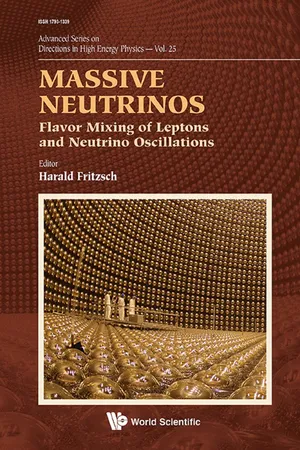
Massive Neutrinos: Flavor Mixing Of Leptons And Neutrino Oscillations
Flavor Mixing of Leptons and Neutrino Oscillations
- 308 pages
- English
- ePUB (mobile friendly)
- Available on iOS & Android
Massive Neutrinos: Flavor Mixing Of Leptons And Neutrino Oscillations
Flavor Mixing of Leptons and Neutrino Oscillations
About This Book
Since the discovery of neutrino oscillations neutrino physics has become an interesting field of research in physics. They imply that neutrino must have a small mass and that the neutrinos, coupled to the charged leptons, are mixtures of the mass eigenstates, analogous to the flavor mixing of the quarks. The mixing angles for the quarks are small, but for the leptons two of the mixing angles are large. The masses of the three neutrinos must be very small, less than 1 eV, but from the oscillation experiments we only know the mass differences — the absolute masses are still unknown. Also we do not know, if the masses of the neutrinos are Dirac masses, as the masses of the charged leptons and of the quarks, or whether they are Majorana masses.
In this volume, an overview of the present state of research in neutrino physics is given by well-known experimentalists and theorists. The contents — originated from talks and discussions at a recent conference addressing some of the most pressing open questions in neutrino physics — range from the oscillation experiments to CP-violation for leptons, to texture zero mass matrices and to the role of neutrinos in astrophysics and cosmology.
Since the discovery of neutrino oscillations neutrino physics has become an interesting field of research in physics. They imply that neutrino must have a small mass and that the neutrinos, coupled to the charged leptons, are mixtures of the mass eigenstates, analogous to the flavor mixing of the quarks. The mixing angles for the quarks are small, but for the leptons two of the mixing angles are large. The masses of the three neutrinos must be very small, less than 1 eV, but from the oscillation experiments we only know the mass differences — the absolute masses are still unknown. Also we do not know, if the masses of the neutrinos are Dirac masses, as the masses of the charged leptons and of the quarks, or whether they are Majorana masses.
In this volume, an overview of the present state of research in neutrino physics is given by well-known experimentalists and theorists. The contents — originated from talks and discussions at a recent conference addressing some of the most pressing open questions in neutrino physics — range from the oscillation experiments to CP-violation for leptons, to texture zero mass matrices and to the role of neutrinos in astrophysics and cosmology.
Readership: Researchers and graduate students in the field of particle physics.
Frequently asked questions
Information
KEK,
Theresienstraße 37, 80333 München, Germany
[email protected]
















Table of contents
- Cover
- Half Title
- Advanced Series on Directions in High Energy Physics
- Title Page
- Copyright
- Preface
- Contents
- 1. Birth of Lepton Flavor Mixing
- 2. Neutrino Masses and Flavor Mixing
- 3. Fermion Mass Matrices, Textures and Beyond
- 4. General Lepton Textures and Their Implications
- 5. Status and Implications of Neutrino Masses: A Brief Panorama
- 6. Neutrino Masses and SO10 Unification
- 7. Relating Small Neutrino Masses and Mixing
- 8. Predictions for the Dirac CP Violation Phase in the Neutrino Mixing Matrix
- 9. Sterile Neutrinos in E6
- 10. Phenomenology of Light Sterile Neutrinos
- 11. Neutrino–Antineutrino Mass Splitting in the Standard Model: Neutrino Oscillation and Baryogenesis
- 12. The Strong CP Problem and Discrete Symmetries
- 13. Neutrino Interaction with Background Matter in a Noninertial Frame
- 14. Seesaw Models with Minimal Flavor Violation
- 15. Generating Majorana Neutrino Masses with Loops
- 16. Three-Neutrino Oscillation Parameters: Status and Prospects
- 17. On the Majorana Neutrinos and Neutrinoless Double Beta Decays
- 18. Dirac or Inverse Seesaw Neutrino Masses from Gauged B – L Symmetry
- 19. Searching for Radiative Neutrino Mass Generation at the LHC
- 20. Lepton-Flavor Violating Signatures in Supersymmetric U(1)′ Seesaw
- 21. From Electromagnetic Neutrinos to New Electromagnetic Radiation Mechanism in Neutrino Fluxes
- 22. Lepton Number Violation and the Baryon Asymmetry of the Universe
- 23. Status of the MAJORANA DEMONSTRATOR: A Search for Neutrinoless Double-Beta Decay
- 24. Towards Neutrino Mass Spectroscopy Using Atoms/Molecules
- 25. Detection Prospects of the Cosmic Neutrino Background
- 26. Supernova Bounds on keV-mass Sterile Neutrinos
- 27. Precision Calculations for Supersymmetric Higgs Bosons
- 28. Minimal Supersymmetric Standard Model with Gauged Baryon and Lepton Numbers
- 29. From the Fourth Color to Spin-Charge Separation — Neutrinos and Spinons
- 30. Measurement of the Underlying Event Activity Using Charged-Particle Jets in Proton–Proton Collisions at √s = 2.76 TeV